sunday
day 1 |
arrivals into LONDON |
|
|
|
It is possible to book pre-nights at the hotel, organize transfers in from the airport, facilitate guides, make restaurant reservations for those who might like to arrive a day or two before the trip begins at our hotel, The Mandarin Oriental Hyde Park London.
Individual arrivals into London throughout the day. Most flights will arrive from LAX into Heathrow between noon and 4:00 pm.
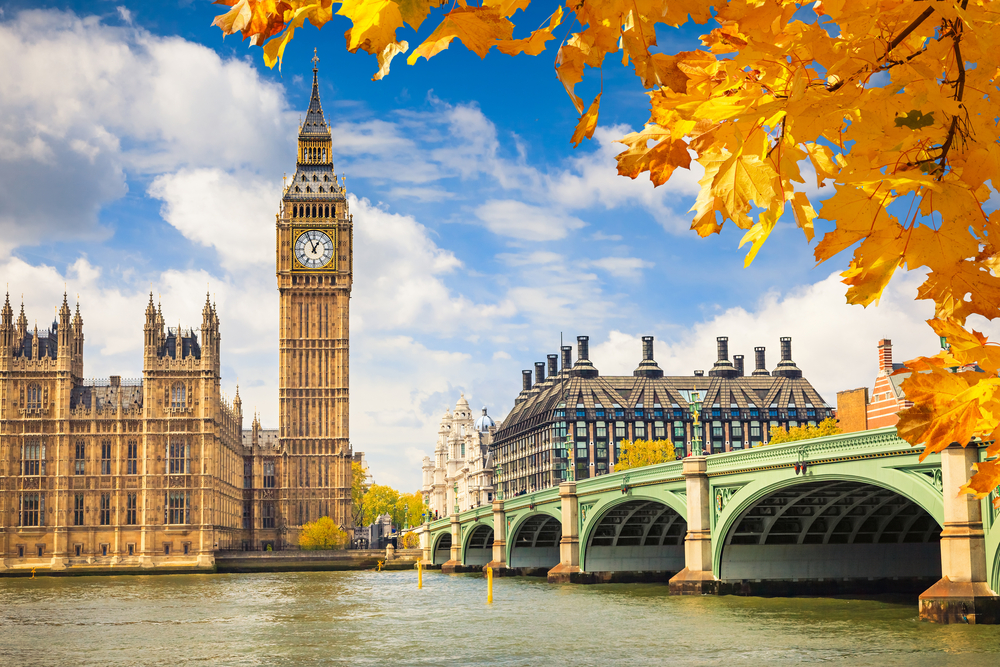
- Taxis are available at the airport for the 45 minute transfer to the hotel. Car and driver can be organized if desired.
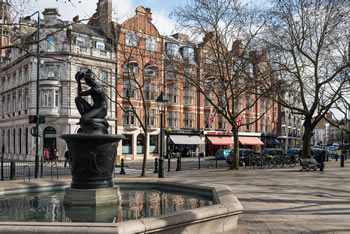
- Check into our deluxe hotel in Knightsbridge, The Mandarin Oriental Hyde Park London, England.
- Time to unpack and settle-in.
- People might like to walk to Sloane Square for a visit of the arts and crafts details and Pre-Raphaelite stained glass of Holy Trinity Church.
Cocktail party, introduction to the upcoming week and gourmet dinner in the elegant and private Loggia dining room which opens onto a private terrace via The Royal Entrance. The Michelin-starred restaurant Dinner by Heston Blumenthal will cater our event. 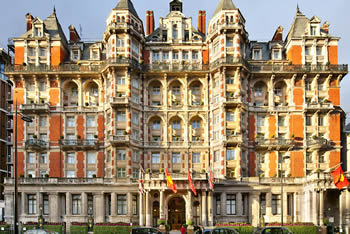
Overnight: The Mandarin Oriental Hyde Park London, England.
One of London's most celebrated hotels offering a blend of elegance, style and luxury. Perfect location overlooking Hyde Park and Knightsbridge and within walking distance of Harrod’s, Harvey Nichols and Green Park. Home to two of the city's best restaurants - Heston Blumenthal’s Dinner and Daniel Boulud’s Bistro - as well as the contemporary-designed Mandarin Bar. Full spa and state-of-the-art fitness center. |
monday
day 2 |
london to bishops tachbrook |
|
| |
|
Full breakfast in the hotel’s restaurant starting at 7:00 am. Check-out and luggage is transferred separately to be waiting in our rooms when we arrive at Mallory Court.
Scenic transfer to Waddesdon Manor for an exclusive closing-day visit.
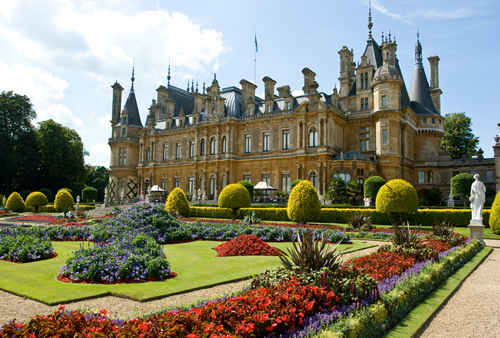
A thorough curator-led visit of the house and collections in the morning.
Baron Ferdinand de Rothschild bought the Waddesdon Estate in 1874 when it was 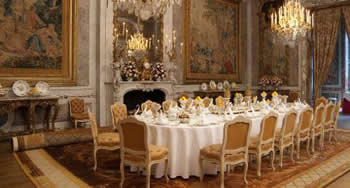 nothing but farmland. He wanted a country retreat in the style of a Loire Valley château and that is exactly what he built. Waddesdon was created as a place to entertain guests at Ferdinand's famous Saturday-to-Monday house parties and they enjoyed all the modern comforts of running water, central heating and electricity. After a few years, Ferdinand discovered that the house was too small for the number of guests he wanted to entertain and added a wing at the west end of the house. nothing but farmland. He wanted a country retreat in the style of a Loire Valley château and that is exactly what he built. Waddesdon was created as a place to entertain guests at Ferdinand's famous Saturday-to-Monday house parties and they enjoyed all the modern comforts of running water, central heating and electricity. After a few years, Ferdinand discovered that the house was too small for the number of guests he wanted to entertain and added a wing at the west end of the house.
The estate passed to Ferdinand’s sister Alice and then to her Parisian great-nephew James de Rothschild and his English wife Dorothy who constructed a golf course and a stud for racehorses on the property. 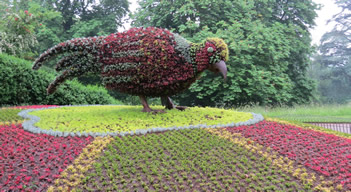 During the Second World War they housed children evacuated from London and after the war, James decided to leave the Manor, its collection and 165 acres of garden and park to The National Trust. To maintain the bequest, he set up the largest endowment the Trust has ever received and ensured the family’s continued involvement by naming his wife as the chairwoman of the management committee. During the Second World War they housed children evacuated from London and after the war, James decided to leave the Manor, its collection and 165 acres of garden and park to The National Trust. To maintain the bequest, he set up the largest endowment the Trust has ever received and ensured the family’s continued involvement by naming his wife as the chairwoman of the management committee.
In 1990, Lord Rothschild initiated an extensive restoration program to recreate the 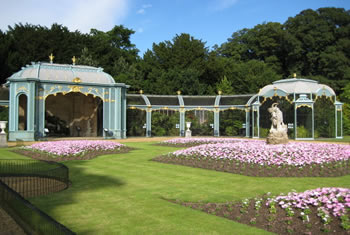 garden's original splendor, including work on the beautiful carpet bedding on the Parterre and in the Aviary Garden, and renovation of the Water Garden at the Dairy. The collection of garden sculpture has also been enriched with the addition of works by contemporary artists. garden's original splendor, including work on the beautiful carpet bedding on the Parterre and in the Aviary Garden, and renovation of the Water Garden at the Dairy. The collection of garden sculpture has also been enriched with the addition of works by contemporary artists.
Waddesdon’s internationally famous collection has been formed principally by the above-mentioned four members of the family. Masterpieces created by the royal French porcelain manufactory of Sèvres are placed on furniture produced by the most significant French craftsmen of the 18th century, much of it made for the royal family and important 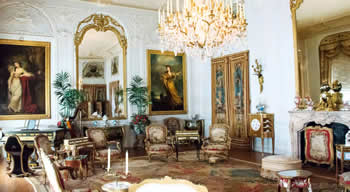 members of the court. The floors are covered with Savonnerie carpets exclusive to the Crown and walls hung with tapestries from the royal Gobelins and Beauvais workshops on top of sumptuous silk fabrics. Paintings from the 17th and 18th centuries by famous Dutch, Flemish and French artists subtly glow from the walls. Baron Ferdinand also prized 18th-century British portraits by Reynolds, Gainsborough and Romney. members of the court. The floors are covered with Savonnerie carpets exclusive to the Crown and walls hung with tapestries from the royal Gobelins and Beauvais workshops on top of sumptuous silk fabrics. Paintings from the 17th and 18th centuries by famous Dutch, Flemish and French artists subtly glow from the walls. Baron Ferdinand also prized 18th-century British portraits by Reynolds, Gainsborough and Romney.
Today, the collection continues to grow through the patronage of Rothschild family trusts. Recent additions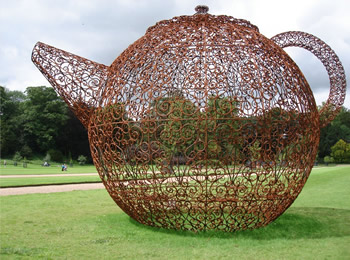 include several superb paintings by Chardin, Labille-Guiard, Pannini and Callet, a magnificent silver dinner service made for George III and a large collection of Sèvres porcelain sculpture. Significant pieces of contemporary sculpture by Stephen Cox, Angus Fairhurst, Sarah Lucas and Richard Long can be seen in the garden and at the Windmill Hill complex that houses the Waddesdon Archive and Rothschild Foundation. include several superb paintings by Chardin, Labille-Guiard, Pannini and Callet, a magnificent silver dinner service made for George III and a large collection of Sèvres porcelain sculpture. Significant pieces of contemporary sculpture by Stephen Cox, Angus Fairhurst, Sarah Lucas and Richard Long can be seen in the garden and at the Windmill Hill complex that houses the Waddesdon Archive and Rothschild Foundation.
Private lunch at Waddesdon Manor with the curators joining us.
Following lunch we take part in specialist sessions with the various curators of Waddesdon. Portraits, porcelain, furniture, gardens, books and works on paper. 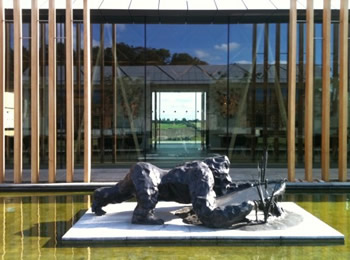
We then continue to Windmill Hill, still on this vast property and the archives of The Rothschild Foundation.
Carry on northwards to our hotel, the 5-star Mallory House in
Bishops Tachbrook on the rural southern outskirts of Royal Leamington Spa.
Check-in, unpack, and some time to relax before dinner.
Dinner in the elegant Michelin-starred dining room at Mallory Court.
Overnight: Mallory Court, Bishops Tachbrook, England. -be43b11f-027f-4b36-a03a-371f5ab7c845-0-605x412.jpg)
This quintessential English country house hotel, a long-standing member of the revered Relais and Châteaux group is set in 10 immaculate acres of garden and park. The Lutyens-style main house houses 19 bedrooms and we will take them all. |
tuesday
day 3 |
bishops tachbrook |
|
| |
|
Full breakfast in the hotel’s restaurant starting at 7:00 am.
Pre-opening private visit of the beautiful estate of Baddesley Clinton.
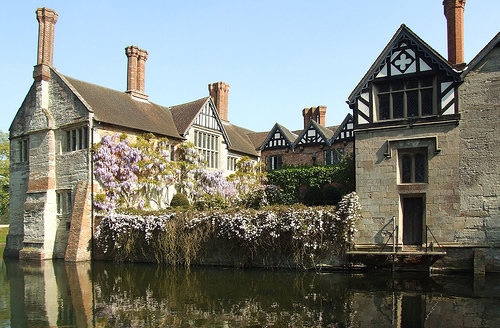
One of the finest moated manor houses in England, Baddesley Clinton has been described as “the perfect late medieval manor house”. The house is hemmed in on all sides by a wide moat with swans floating peacefully in the water and sits next to a lovely formal garden. The manor was begun in the 13th century in a Saxon clearing in the Forest of Arden but the house we see today was built in the 15th century. It has 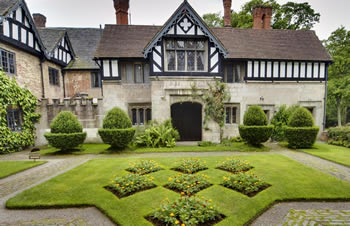 remained essentially unchanged since the 1630s due to the fact that Baddesley Clinton was the home of the Ferrers family for 500 years passing from father to son for 12 generations before finally being sold in 1940. remained essentially unchanged since the 1630s due to the fact that Baddesley Clinton was the home of the Ferrers family for 500 years passing from father to son for 12 generations before finally being sold in 1940.
The Ferrers remained Roman Catholic recusants after the Reformation, along with many other members of the Warwickshire gentry. They sheltered Jesuit priests, who were under the threat of a death sentence if discovered, and made special provision to hide and protect them. Several priest holes were built, secret passages to hide people in the event of a search. One hole is off the Moat Room, and is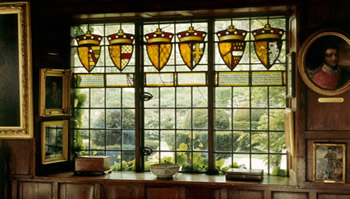 simply a small room with a door hidden in the wood paneling. A second leads into the ceiling, and though not visible to visitors, is reputed to be able to hold six people. A third is hidden in an old toilet. Fugitives could slide down a rope from the first floor through the old garderobe shaft into the house's former sewers, which run the length of the building. These priest holes were built by Saint Nicholas Owen, a lay-brother of the Jesuits who made many masterful hides throughout England. He was eventually caught and tortured to death by the Protestant English government. simply a small room with a door hidden in the wood paneling. A second leads into the ceiling, and though not visible to visitors, is reputed to be able to hold six people. A third is hidden in an old toilet. Fugitives could slide down a rope from the first floor through the old garderobe shaft into the house's former sewers, which run the length of the building. These priest holes were built by Saint Nicholas Owen, a lay-brother of the Jesuits who made many masterful hides throughout England. He was eventually caught and tortured to death by the Protestant English government.
Coffee and tea at Baddesley Clinton following our visit of the house and garden.
Short drive to Packwood House.
Visit of the garden at Packwood House with the estate’s Head Gardener.
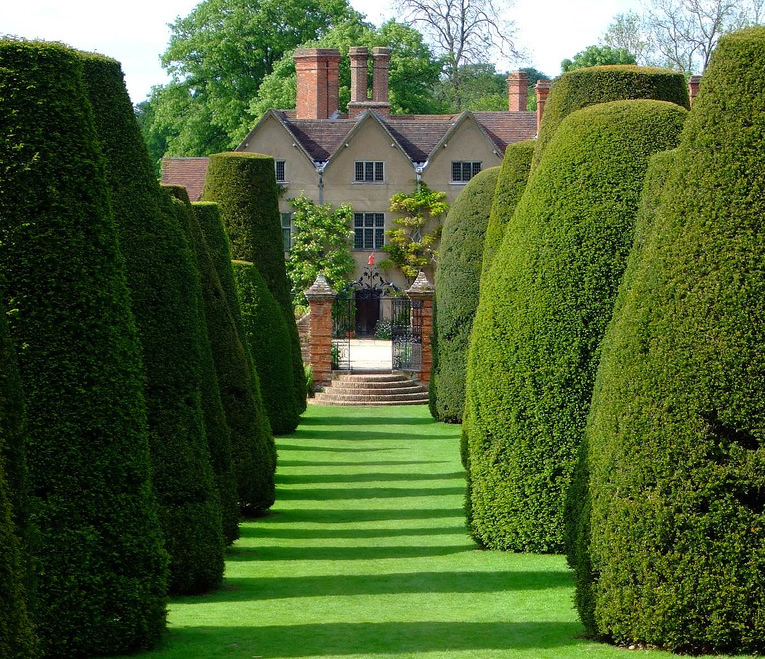
Packwood House is a timber-framed Tudor manor house with a wealth of tapestries and fine furniture but it is known primarily for its famous Yew Garden containing over 100 trees laid out in the mid-17th century. The clipped yews are supposed to represent "The Sermon on the Mount". Twelve great yews are known as the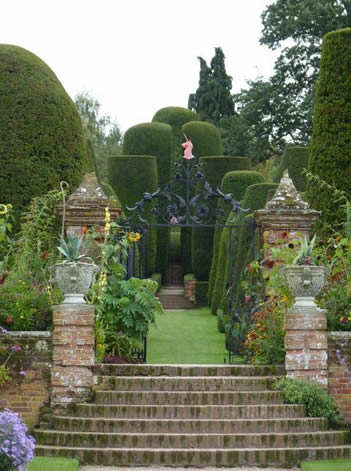 "Apostles" and the four big specimens in the middle are 'The Evangelists'. A tight spiral path lined with box hedges climbs a hummock named "The Mount". The single yew that crowns the summit is known as "The Master". The smaller yew trees are called "The Multitude" and were planted in the 19th century to replace an orchard. Some of the yews at Packwood are taller than 50 feet and the garden appears on the cover of Sir Roy Strong’s book on “The Renaissance Garden in England.” "Apostles" and the four big specimens in the middle are 'The Evangelists'. A tight spiral path lined with box hedges climbs a hummock named "The Mount". The single yew that crowns the summit is known as "The Master". The smaller yew trees are called "The Multitude" and were planted in the 19th century to replace an orchard. Some of the yews at Packwood are taller than 50 feet and the garden appears on the cover of Sir Roy Strong’s book on “The Renaissance Garden in England.”
Simple lunch in the café at Packwood House.
Visit of Packwood House interior with the estate’s curators.
Back to the hotel by mid-afternoon for some time to relax.
After-hours sunset visit of the garden at Charlecote followed by a visit of the magnificent house.
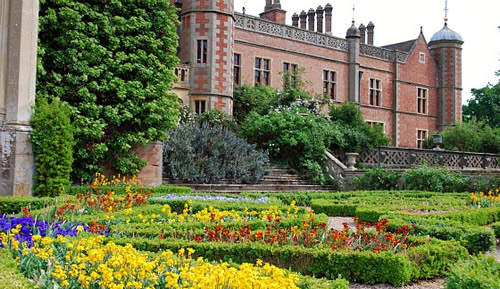
Charlecote has been home to the Lucy family since the 12th century and their stories are told throughout the house with their portraits and the objects they collected from around the world. The gardens include a formal parterre, colorful herbaceous planting, a woodland walk and the wider parkland inspired by 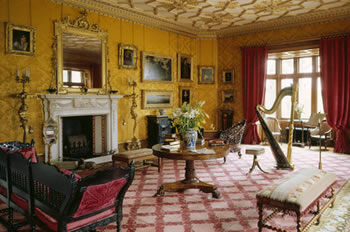 'Capability' Brown. A herd of fallow deer has been in the park since Tudor times. There are portraits of every generation of the family throughout the house and some of them have colorful stories to tell. 'Capability' Brown. A herd of fallow deer has been in the park since Tudor times. There are portraits of every generation of the family throughout the house and some of them have colorful stories to tell.
In 1572 Sir Thomas Lucy went to vast expense to entertain Elizabeth I, who visited Charlecote on her way from lavish entertainment at nearby Kenilworth Castle. The date is immortalized in stone over the front porch he had built in her honor. She is said to have slept in what is now the Drawing Room.
Local legend has it that the young William Shakespeare was caught poaching deer on the Charlec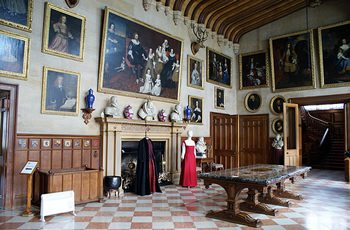 ote estate. Meting out justice in the Great Hall, the local magistrate of the time was Sir Thomas Lucy. Shakespeare is said to have taken his revenge by portraying Sir Thomas as the fussy Justice Shallow in ‘The Merry Wives of Windsor’, poking fun at his coat of arms and his pride in his ancestors. One of the treasures of Charlecote’s exceptional library is the 1632 Second Folio of Shakespeare’s works. ote estate. Meting out justice in the Great Hall, the local magistrate of the time was Sir Thomas Lucy. Shakespeare is said to have taken his revenge by portraying Sir Thomas as the fussy Justice Shallow in ‘The Merry Wives of Windsor’, poking fun at his coat of arms and his pride in his ancestors. One of the treasures of Charlecote’s exceptional library is the 1632 Second Folio of Shakespeare’s works.
During the Civil War, Spencer Lucy initially sided with the King. Then the Lucys bribed their way to favo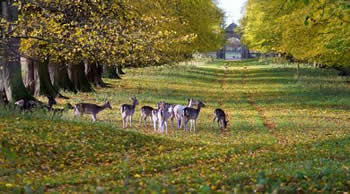 r with Parliament during the tenure of Spencer's brother Robert. Finally, the youngest brother Richard inherited and allied himself with Charles II during the Restoration. The ‘reconciliation’ was helped by the payment of a hefty fine of £3,513 – equivalent to the Lucy family’s entire annual income from their estates and worth around £5.5 million today. r with Parliament during the tenure of Spencer's brother Robert. Finally, the youngest brother Richard inherited and allied himself with Charles II during the Restoration. The ‘reconciliation’ was helped by the payment of a hefty fine of £3,513 – equivalent to the Lucy family’s entire annual income from their estates and worth around £5.5 million today.
After a quiet couple of decades, in 1744 Charlecote was inherited by the Colonel’s nephew, another George Lucy – a wild bachelor with a love of travel, fashion and married women. From his travels in Portugal in 1755 he brought back the first flock of Jacob sheep in the UK to Charlecote’s parkland. He 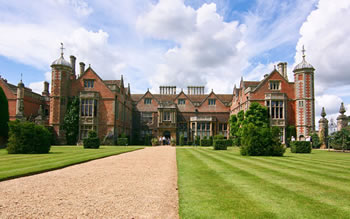 called in ‘Capability’ Brown to work on the gardens and in 1769 he helped revive the story of Shakespeare poaching Charlecote deer at the Shakespeare Jubilee organized by David Garrick in Stratford-upon-Avon. called in ‘Capability’ Brown to work on the gardens and in 1769 he helped revive the story of Shakespeare poaching Charlecote deer at the Shakespeare Jubilee organized by David Garrick in Stratford-upon-Avon.
The Shakespeare connection continues to this day with the present RSC production of “Loves Labours Lost” using Charlecote as a video backdrop on stage.
Drinks and dinner in the private apartments of Charlecote House. Overnight: Mallory Court, Bishops Tachbrook, England. |
wednesday
day 4 |
bishops tachbrook |
|
| |
|
Full breakfast in the hotel’s restaurant starting at 7:00 am.
Short pleasant drive for a private before-hours house and garden tour of Hanbury Hall.
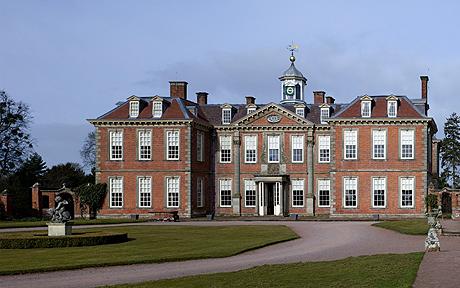
From the Norman Conquest onwards, the Hanbury estate was within the boundaries of the Royal Forest of Feckenham. Feckenham's royal status was lost in 1629 and local families like the Vernons bought up land to increase their own estates. The building of the Hall started in 1701 but despite the 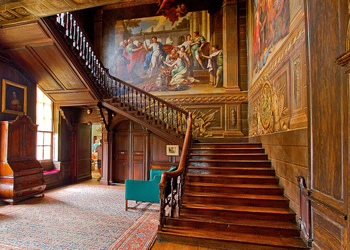 proudly displayed Vernon family crest with the moto “Vernon always flourishes”, the theatrical family story reads like a soap opera and Steve Hindle will use the family to lead us through numerous interesting episodes in British history. proudly displayed Vernon family crest with the moto “Vernon always flourishes”, the theatrical family story reads like a soap opera and Steve Hindle will use the family to lead us through numerous interesting episodes in British history.
Physically, the most impressive feature of Hanbury is the extraordinary main staircase. This is truly a jaw-dropping work of art on a massive scale. Every surface of the walls lining the stair and the ceiling at the top of the staircase opening are covered in extraordinary murals illustrating scenes from Greek myth. The murals were painted by Sir James Thornhill (1675-1734), who was responsible for the Dome of St Paul's Cathedral, the Painted Hall at Greenwich, and the Great Hall of Blenheim Palace.
Lunch at The Boot in nearby Lapworth.
Private closing day visit at Coughton Court of both house and garden.
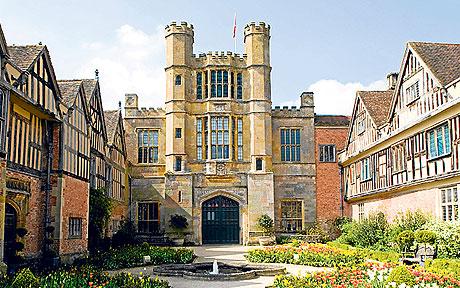
It is believed that there was a medieval house on the site when John de Throckmorton arrived in 1409 to marry into the de Spiney family. Since that time, Coughton Court has been home to the Throckmortons, one of the UK’s oldest Catholic families. This year the family is celebrating its 606th 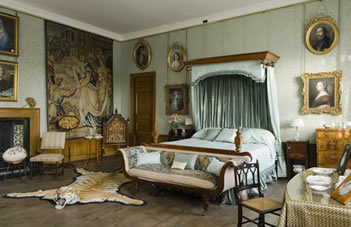 year of residence at Coughton Court. year of residence at Coughton Court.
Through its rich and varied history, the house has witnessed some of the most defining moments in British history – from the intrigues of the court of Henry VIII to the Throckmorton Plot to murder Queen Elizabeth I to the Gunpowder Plot of 1605 – and it is one of the last remaining Roman Catholic houses in the country to retain its historic treasures. It houses one of the very best collections of portraits and memorabilia of this family from the early Tudor times. Alongside family items on display, there are pieces such as the chemise reputedly worn by Mary Queen of Scots when she was executed and a bishop’s Cope, with intricate needlework, believed to have been worked upon by Catherine of Aragon. 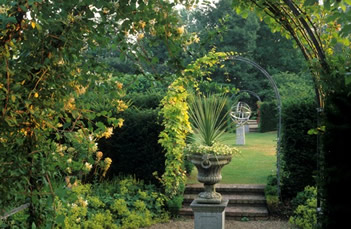
But the main attractions are the Coughton Court’s gardens, designed by Christina Williams daughter of Clare McLaren-Throckmorton, the present owner of the property. In 2006, the gardens were given the Award of Garden Excellence by the World Federation of Rose Societies, the first time such an accolade has been awarded to a garden in the UK. The National Daffodil Society awarded a Gilt Medal for the outstanding display of daffodils, of which there are now over 400,000.
Back to hotel by mid-afternoon for some time to relax.
Private after-hours private visit of Compton Verney conducted by the Director. This will be followed by drinks and dinner in the collection.
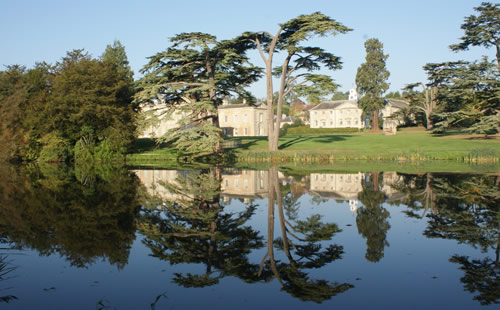
The first record of a settlement at Compton Verney was the late Saxon village of Compton. By the time of the Domesday Book in 1086, the village was divided into two manors - the largest held by the Count of Meulan and this property inherited by the Earls of Warwick, who held it in the king’s name.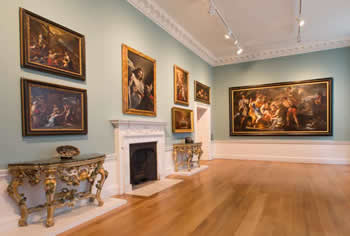
In 1435, the property was acquired by the ruthless and ambitious Richard Verney with the assistance of his younger brother John Verney, Dean of Lichfield, and the powerful Richard Beauchamp, Earl of Warwick. The Verney family had begun acquiring lands in the area of Compton Murdak and the surrounding villages in the 1430s before purchasing the estate. By about 1500 it was so closely associated with them that it began to be known as Compton Verney.
And for 500 years right up until the early 20thC, Compton Verney was home to the Ver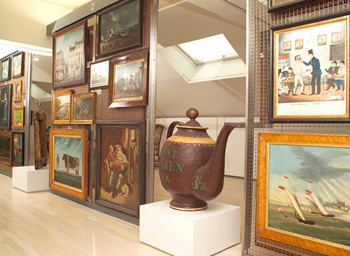 ney family. But at this point the house and land changed hands a number of times, the property fell derelict and parts of the land and house were sold off. The situation was extremely sad but in 1993, the house was rescued by the Compton Verney House Trust, who purchased the house and immediate grounds thanks to a generous grant from the Peter Moores Foundation. The extensive building program gave it a new life as an art gallery. The building program started by conserving the Georgian Mansion and the adjacent servants buildings (now the Learning Center), then a contemporary extension between the two was created. The transformation took ten years to complete and Compton Verney was finally able to open its doors to welcome visitors in March 2004. Compton Verney is now a unique place where art, architecture, landscape and learning fuse. ney family. But at this point the house and land changed hands a number of times, the property fell derelict and parts of the land and house were sold off. The situation was extremely sad but in 1993, the house was rescued by the Compton Verney House Trust, who purchased the house and immediate grounds thanks to a generous grant from the Peter Moores Foundation. The extensive building program gave it a new life as an art gallery. The building program started by conserving the Georgian Mansion and the adjacent servants buildings (now the Learning Center), then a contemporary extension between the two was created. The transformation took ten years to complete and Compton Verney was finally able to open its doors to welcome visitors in March 2004. Compton Verney is now a unique place where art, architecture, landscape and learning fuse.
Overnight: Mallory Court, Bishops Tachbrook, England. |
thursday
day 5 |
bishops tachbrook |
|
| |
|
Full breakfast in the hotel’s restaurant starting at 7:00 am.
Morning visit of historic Kenilworth Castle taking in the grounds, the ruins and the still-standing buildings.
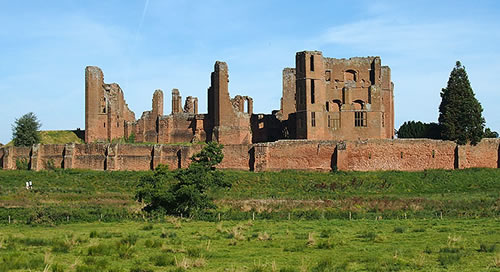
Kenilworth is one of England’s most magnificent castles. Once standing at the heart of a 4,000-acre hunting ground and surrounded by a vast man-made lake, it represented a rich prize to the generation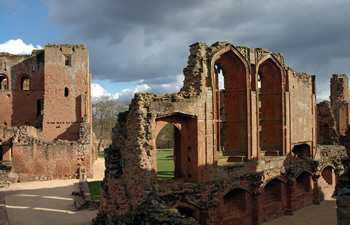 s of royal and almost-royal great men who owned and embellished it - Geoffrey de Clinton, John of Gaunt, Henry V, and Robert Dudley, Earl of Leicester. Even in melancholy decay its influence has been far-reaching, thanks, in part, to Walter Scott’s best-selling romance, “Kenilworth” which brought the castle new fame. s of royal and almost-royal great men who owned and embellished it - Geoffrey de Clinton, John of Gaunt, Henry V, and Robert Dudley, Earl of Leicester. Even in melancholy decay its influence has been far-reaching, thanks, in part, to Walter Scott’s best-selling romance, “Kenilworth” which brought the castle new fame.
The first castle was established in the 1120s by the Royal Chamberlain, Geoffrey de Clinton. He built most of the Norman keep, and founded the nearby priory. In the early 13thC, King John added an outer circuit of stone walls and a dam to hold back a great lake, thus creating one of the kingdom’s most impressive castles. 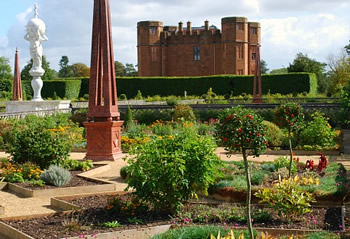
Subsequently the castle was developed as a palace. John of Gaunt, son of Edward III, constructed the great hall and associated apartments. In the 15th century, the castle was the favored residence of the Lancastrian kings, drawn here by the excellent hunting. Henry V built a retreat – the Pleasance in the Marsh – at the far end of the lake.
In 1563, Elizabeth I granted the castle to her favorite, Robert Dudley, Earl of Leicester. He turned Kenilworth into a great Renaissance 'prodigy house', designed to receive the queen and her court on their ceremonial 'progresses' around her realm. Striking evidence of Dudley's transformation can still be seen everywhere at Kenilworth, 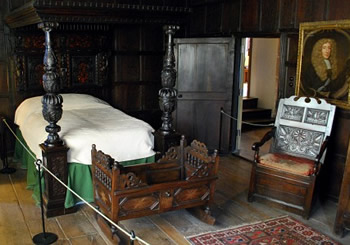 not least in the form of the new garden, recreated by English Heritage on the basis of a contemporary description, representing the one that Dudley had made for the 19 days of festivities laid on for Elizabeth I's visit in 1575. not least in the form of the new garden, recreated by English Heritage on the basis of a contemporary description, representing the one that Dudley had made for the 19 days of festivities laid on for Elizabeth I's visit in 1575.
The castle's fortifications were dismantled in 1650, after the Civil War. In 1821, the ivy-clad ruins became famous as the setting for Sir Walter Scott’s novel, ‘Kenilworth’, which romanticized the story of Robert Dudley, Elizabeth I and Amy Robsart. In 1958, Lord Kenilworth gave the castle to the town, and since 1984, it has been managed by English Heritage.
Lunch at The Stag in nearby Offchurch.
Return to our hotel following lunch for some time to change for the evening.
Mid-afternoon departure for Stratford-upon-Avon and the Royal Shakespeare Theatre.
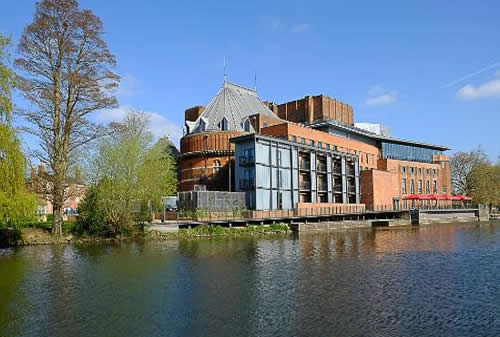
The Royal Shakespeare Company (RSC) is a major British theater company, based in Stratford-upon-Avon, Warwickshire, England. The company employs 700 staff and produces around 20 productions a year from its home in Stratford-upon-Avon and plays regularly in London, Newcastle-upon-Ty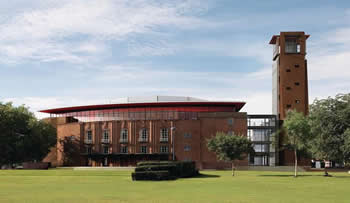 ne and on tour across the UK and internationally. ne and on tour across the UK and internationally.
The recently re-developed Royal Shakespeare Theatre (a 1,060 seat theater with thrust stage) and adjacent Swan Theatre (a smaller thrust stage, capacity 461) were part of a £113-million "Transformation" project and re-opened in November 2010 having been closed for three years.
As well as the plays of Shakespeare and his contemporaries, the RSC produces new work from living artists and develops creative links with theater-makers from around the world, as well as working with teachers to inspire a lifelong love of William Shakespeare in young people and running events for everyone to explore and participate in its work.
Exclusive workshop with an RSC Practitioner. 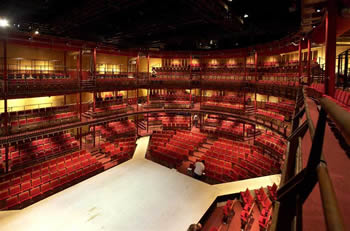
Following our workshop we enjoy dinner in the Rooftop Restauant at the Swan Theater.
7:30 pm performance of a Shakespearean play. We will have the very best seats in the house.
Back to hotel for cheese, wine, cognac and dessert so that we can discuss the play together.
Overnight: Mallory Court, Bishops Tachbrook, England. |
friday
day 6 |
bishops tachbrook to lower slaughter |
|
| |
|
Full breakfast in the hotel’s restaurant starting at 7:00 am. Following a later breakfast we check-out and bags travel to our next hotel by separate luggage van to be waiting in our rooms when we arrive.
Late-morning private closing day visit at Upton House and Garden. Coffee break and scones in between the house and the garden visits. 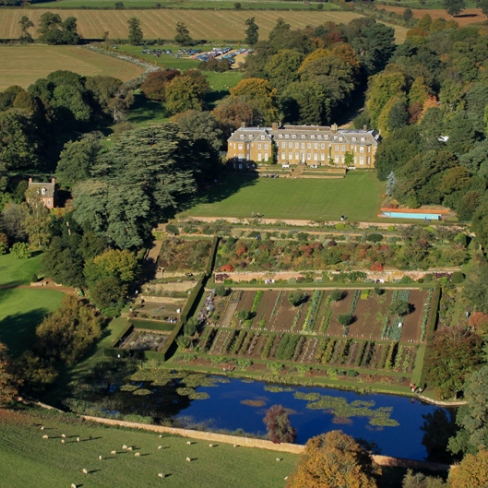
Upton House was built in 1452 and passed through many hands until it was bought Lord Bearsted in 1927. The garden is lovely but perhaps uniquely among country houses owned by the National Trust, its significance lies principally in its art collection. The house is presented more as an art gallery than as a private home, although care has been taken to restore the house to how it looked in the 1930s.
The collection was assembled by Lord Bearsted ( helped by his being a Trustee of the National Gallery) and includes English and Continental Old Masters such as Tiepolo, Anthony Devis, Francesco Guardi, Jan Steen, Melchior de Hondecoeter, Thomas Gainsborough, Joshua Reynolds, Tintoretto and Rogier van der Weyden. Other highlights of the collection include works by George Romney, Hieronymous Bosch, Canaletto, Pieter Bruegel the Elder, William Hogarth, George Stubbs and El Greco.
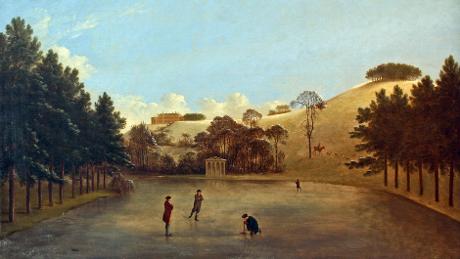
Following our visits we continue south to the beautiful town of Chipping Campden.
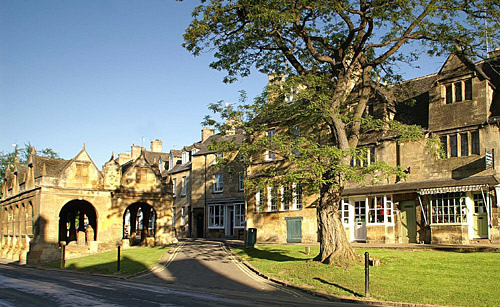
Chipping Campden developed from a medieval village whose existence is first documented in the Domesday Book of 1086. Here, it is recorded as "Campedene", the prefix "Chipping", an old English word meaning "market", was added in the 1200s. It became an important wool town in the Middle Ages and 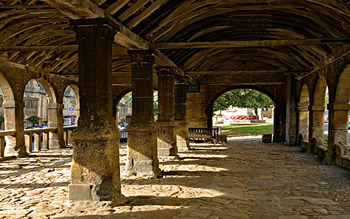 proceeds from the wool trade were used to build St James's, a 500-year-old wool church to the north of the town. Examples of Early Modern architecture which survive in the town include the Market Hall, which was built in 1627 by Sir Baptist Hicks, and the Alms Houses, which were built in 1612 by the same architect. These houses, which are overlooked by the garden of the Eight Bells inn (a good place to have lunch), were intended to be the residence of twelve pensioners, a purpose for which they are still used today. proceeds from the wool trade were used to build St James's, a 500-year-old wool church to the north of the town. Examples of Early Modern architecture which survive in the town include the Market Hall, which was built in 1627 by Sir Baptist Hicks, and the Alms Houses, which were built in 1612 by the same architect. These houses, which are overlooked by the garden of the Eight Bells inn (a good place to have lunch), were intended to be the residence of twelve pensioners, a purpose for which they are still used today.
The Guild of Handicraft was founded in 1888 by Charles Ashbee, an architect and devotee of William 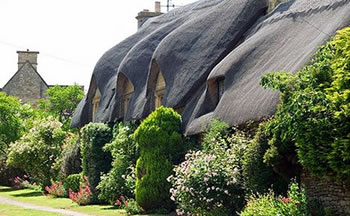 Morris. Its aim was to spark a revival in traditional craftsmanship, which had been in decline since the Industrial Revolution. In an effort to improve the quality of life of his craftsmen, Ashbee moved the Guild from workshops in the East End of London to Chipping Campden, in the center of the Cotswolds, in 1902. Morris. Its aim was to spark a revival in traditional craftsmanship, which had been in decline since the Industrial Revolution. In an effort to improve the quality of life of his craftsmen, Ashbee moved the Guild from workshops in the East End of London to Chipping Campden, in the center of the Cotswolds, in 1902.
The Guild, some 200 people in all, including wives and children, descended on the town. The craftsmen brought with them fresh ideas, making the market town a center for the study of Arts and Crafts and contemporary design in the early part of the 20th century. The Guild of Handicraft survives today as Hart Gold and Silversmiths, a com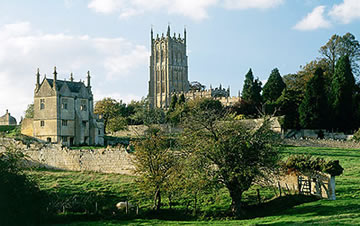 pany which consists of four individual gold and silversmiths who share the work and the costs involved in running the workshop. Today, the craftsmen’s work is a mix of private commissions from tiny thimbles to larger pieces of presentational silverware, reproductions as well as commissions for the ecclesiastical silverware market. The business is run by David Hart, the grandson of one of Charles Ashbee’s original craftsmen who remained in Chipping Campden. pany which consists of four individual gold and silversmiths who share the work and the costs involved in running the workshop. Today, the craftsmen’s work is a mix of private commissions from tiny thimbles to larger pieces of presentational silverware, reproductions as well as commissions for the ecclesiastical silverware market. The business is run by David Hart, the grandson of one of Charles Ashbee’s original craftsmen who remained in Chipping Campden.
Lunch at leisure in Chipping Campden. Lots of choice between pubs, bistros, tea rooms and sandwich shops. 
To the Court Barn for a private visit of the Arts & Crafts exhibition. Followed by a guided walking tour of the village with a local historian. End at the Guild Silversmiths for a private visit with the owner. Some time to shop following.
Transfer to our stunning village of Lower Slaughter.
Lower Slaughter, set deep in the country of Gloucestershire in the Cotswolds district will be our village home for four nights. The village is built on both banks of the River Eye and at the west end of the village there is a 19th-century water mill with an undershot waterwheel and a chimney for additional steam power. There is a ford where the river widens in the village and several small stone footbridges join the two sides of the community. While the mill is built of red brick most of the 16th and 17th-century homes in the village use Cotswold sandstone and are adorned with mullioned windows and often with other embellishments such as projecting gables.

Records exist showing that Lower Slaughter has been inhabited for over 1000 years and it is duly listed in The Domesday Book. The village has won the Bledisloe Cup three times for the Best Kept Village in England and its main (only) street has been voted The Most Romantic Road in England by a Google Street View poll.

In May last year it was reported in the national news that the Parish Council were fiercely opposed to the presence of an icebox tricycle selling ice creams claiming that the increased footfall would prevent the grass from growing properly and that children might climb on the trike and fall into the nearby river.
Time to unpack, enjoy the grounds, and settle in before drinks followed by dinner at the gastronomic restaurant of our hotel.
Overnight: Lower Slaughter Manor, Lower Slaughter Village, England
Lower Slaughter Manor is a beautiful 17th-century Grade II listed manor house overlooking vibrant green lawns, mature trees and the tiny stream babbling through the heart of the village. It has been awarded Three Rosettes by The AA Restaurant Guide and the hotel will be exclusively ours during our stay.
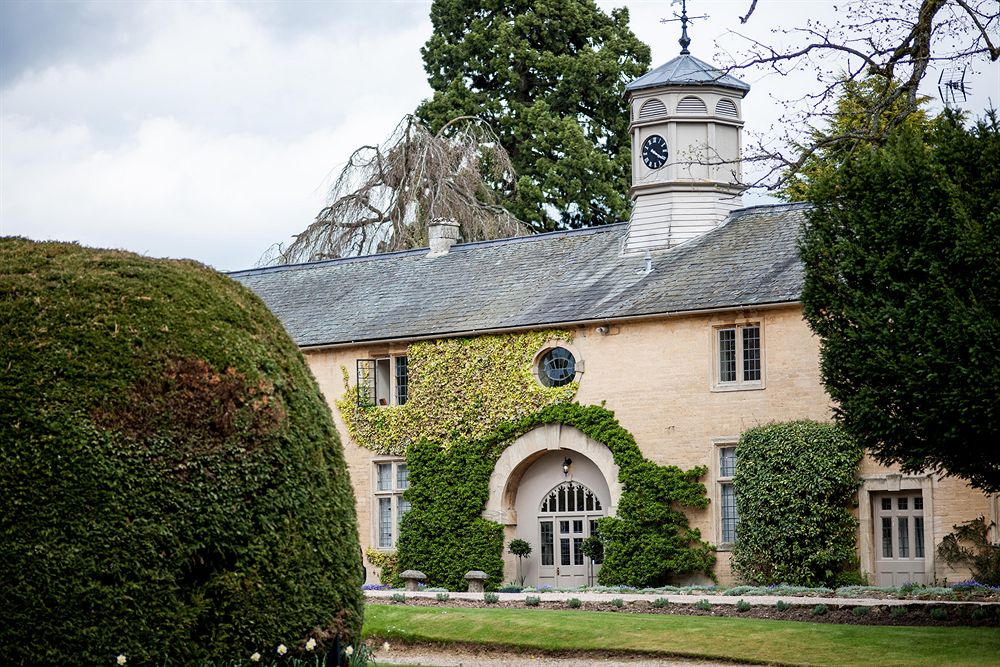
|
saturday
day 7 |
lower slaughter |
|
| |
|
Full breakfast in the hotel’s restaurant starting at 7:00 am.
Private pre-opening morning visit of Hailes Abbey with local expert.
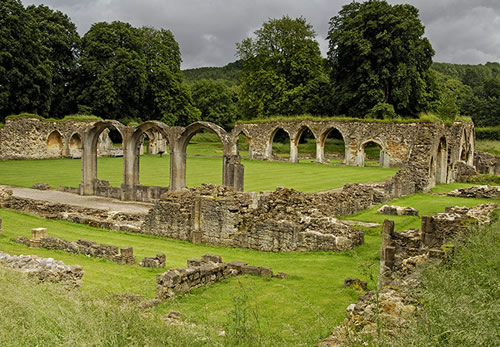
The abbey was founded in 1246 by Richard, Earl of Cornwall, called "King of the Romans" and the younger brother of King Henry III of England. Richard founded the abbey to thank God after he had survived a shipwreck. Richard had been granted the manor of Hailes by King Henry, and settled it with Cistercian monks from Beaulieu Abbey in Hampshire. The great Cistercian abbey was entirely built in a single campaign in 1277, and was consecrated in a royal ceremony that included the King and Queen and 15 bishops.
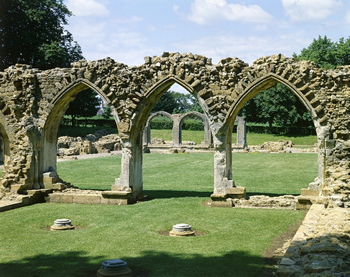
Hailes Abbey became a site of pilgrimage after Richard's son Edmund donated to the Cistercian community a phial of the Holy Blood, purchased in Germany, in 1270. Such a relic of the Crucifixion was a considerable magnet for pilgrimage. From the proceeds, the monks of Hailes were able to rebuild the Abbey on a magnificent scale. Though King Henry VIII's commissioners declared the famous relic to be nothing but the blood of a duck, regularly renewed, and though the Abbot Stephen Sagar admitted that the Holy Blood was a fake in hope of saving the Abbey, Hailes Abbey was one of the last religious institutions to acquiesce following the Dissolution Act of 1536. The Abbot and his monks finally surrendered their abbey to Henry's commissioners on Christmas Eve 1539.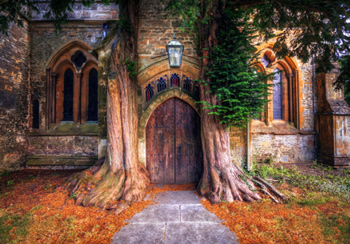
Short drive to historic Stow-on-the-Wold for a guided visit of town and church.
Stow-on-the-Wold is a delightful market town with a population of about 2000 and is among the best known of the small Cotswolds towns. At the height of the Cotswold wool industry, the town was famous for its huge annual fairs where as many as 20,000 sheep were sold at one time. The vast Market Square testifies to the town’s former importance.
Lunch at leisure in Stow-on-the-Wold.
Short transfer back to our hotel for some time to relax and change.
Late afternoon arrival at Hidcote for an after-hours visit of their remarkable gardens. We will first enjoy a presentation in the chapel and then Head Gardener will take us on our private visit.
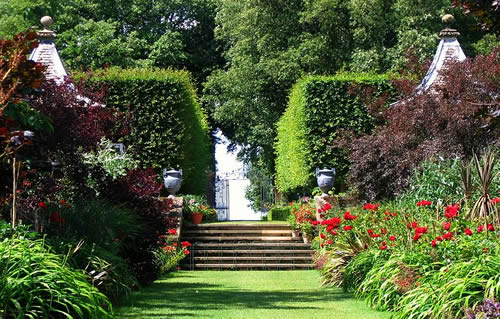
Hidcote is an Arts and Crafts garden in the north Cotswolds, a stone’s throw from Stratford-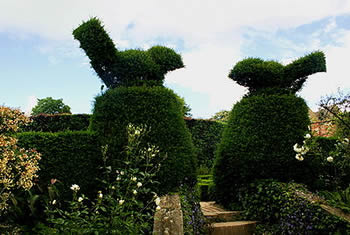 upon-Avon. Created by the talented American horticulturist, Major Lawrence Johnston its colorful and intricately designed outdoor ‘rooms’ are always full of surprises. upon-Avon. Created by the talented American horticulturist, Major Lawrence Johnston its colorful and intricately designed outdoor ‘rooms’ are always full of surprises.
Johnston had an interesting life. Although both of his parents were American he was actually born in Paris. After studying Classics at Cambridge he became a naturalized British citizen and fought in the Boer War and First World War. Following his retirement from the army, Johnston had the time and money to pursue his other interests like painting, music, traveling, entertaining and playing his favorite sport - tennis. However, he always found the time and energy to devote to his garden.
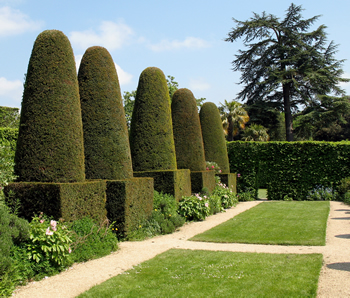
When Johnston started gardening here he found the estate was very exposed. To provide shelter from the wind, he planted evergreen oaks and hedges of holly, hornbeam, beech and yew. These divided the garden into a series of compartments or 'rooms', built around two main corridors that gave breath-taking views over the surrounding countryside.
Each of the garden rooms had its own character and atmosphere with Johnston following the design principles of the fashionable Arts and Crafts movement. He intentionally made those areas close to the house formal in design and structure, with those further away more naturalistic. The architectural lines of the hedges and structures such as steps and pavilions show how Johnston was inspired by his many journeys to France and Italy.
Drinks will follow in the Green House and then we will leave for dinner as the sun begins to set.
Private after-hours visit of Lodge Park with Curator.
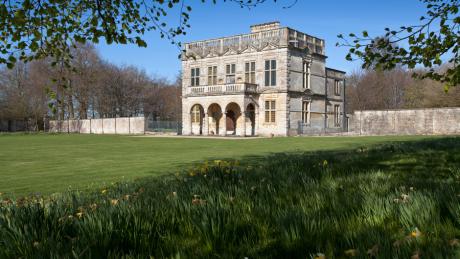
In the early 1630s John 'Crump' Dutton, fueled by his passion for deer coursing, gambling, banqueting and entertaining, created a deer course on his Sherborne Estate that consisted of a park for containing the deer, a mile-long walled enclosure for the chase, and, overlooking the finish, a grandstand. As originally 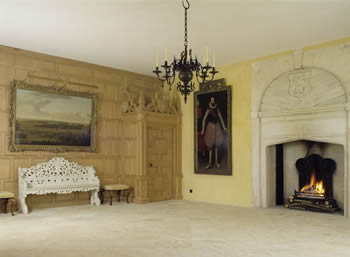 constructed, the grandstand consisted of two levels with a flat roof and a basement. The ground floor was the entrance hall for welcoming guests, and the first floor consisted of the Great Room where the guests were entertained. The deer coursing could be observed from the flat roof or from the balcony over the portico. It is England's only surviving 17th-century deer course and grandstand. constructed, the grandstand consisted of two levels with a flat roof and a basement. The ground floor was the entrance hall for welcoming guests, and the first floor consisted of the Great Room where the guests were entertained. The deer coursing could be observed from the flat roof or from the balcony over the portico. It is England's only surviving 17th-century deer course and grandstand.
Drinks and dinner at the estate.
Overnight: Lower Slaughter Manor, Lower Slaughter Village, England |
SUNDAY
day 8 |
lower slaughter |
|
| |
|
Full breakfast in the hotel’s restaurant starting at 7:00 am.
Short lovely drive to a private guided visit at the fascinating Chedworth Roman Villa.
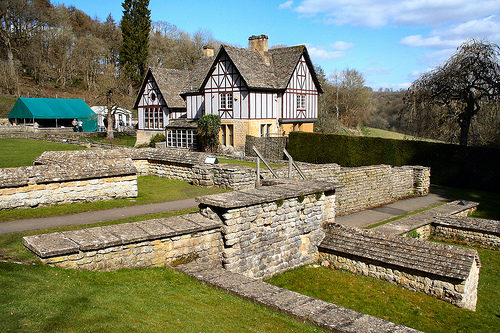
The Chedworth Roman Villa is a one of the largest Roman villas in Britain and was built in phases from the early 2nd century to the 4th century. The 4th-century building included a heated and furnished west wing containing a dining-room with a fine mosaic floor, as well as two separate bathing suites – one for damp-heat and one for dry-heat. 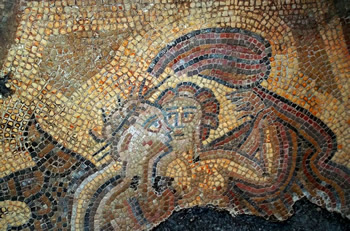
The villa stands in a sheltered, but shady, position overlooking the River Coln just off the Roman road known as the Fosse Way and 8 miles north of the important town of Corinium Dobunnorum (present-day Cirencester). It was one of about fifty villas in the Cotswolds and one of nine in just a 5-mile radius. The villa was located next to a natural spring in the north-west corner of the complex, which was the villa's main source of water, and which was where the inhabitants built a shrine to the water-nymphs.
In June 1864 two men working on the Stowell Park Estate were ferreting for rabbits in 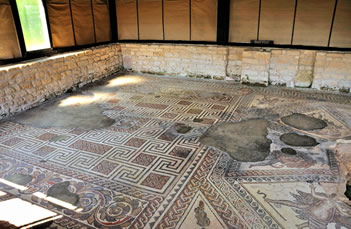 the woods when their ferret got stuck down a hole. As they dug the ferret out, a small patch of mosaic pavement was revealed. Realizing the significance of the find they reported it and it came to the attention of the young landowner, 19-year-old Lord Eldon. His uncle and guardian, James Farrer, was a keen antiquarian and organized excavation of the site over the summer of 1864. the woods when their ferret got stuck down a hole. As they dug the ferret out, a small patch of mosaic pavement was revealed. Realizing the significance of the find they reported it and it came to the attention of the young landowner, 19-year-old Lord Eldon. His uncle and guardian, James Farrer, was a keen antiquarian and organized excavation of the site over the summer of 1864.
The dig revealed a series of huge and impressively intact mosaic floors, two bath houses, a water shrine, and over a mile of Roman walls. By 1865 a museum had been built on site, along with cover buildings to protect the main mosaics, and the villa ruins were being displayed to the visiting public. News of the dig spread and in 1924 a public subscription bought the site from the Stowell Park Estate for the National Trust.
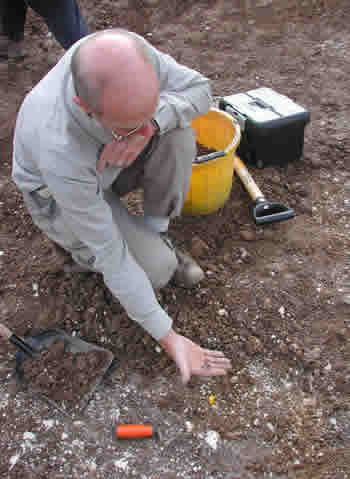
The Victorians who discovered Chedworth and protected it for the nation were trailblazing. Although we may not necessarily agree with the conservation practices they favored, we should applaud the recognition that their discovery was something special that needed protection. Today Chedworth is still a pioneering centre for research, with strong links to several UK universities and academics, an exciting program of live archaeology and a strong education program both onsite and as an outreach.
New discoveries are being made all the time. In 2012, new finds included a second-century bathhouse, several buried mosaics and an impressive silver ring. The cover building that opened in 2012 has won several awards for its innovative approach to conservation.
Following this we will take a short drive to Bourton-on-the-Water for a guided visit of this beautiful town.
Bourton-on-the-Water is a village within the Cotswolds Area of Outstanding Natural 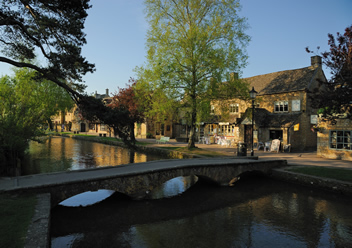 Beauty. The village has a population of 3,297 inhabitants making it a rather large village as its population actually exceeds those of nearby Stow-on-the-Wold and Burford, both of which are considered small market towns. The village is known for its picturesque High Street, flanked by long wide greens and the River Windrush that runs through them. The river is crossed by several low, arched stone bridges. These arched bridges have led to Bourton-on-the-Water being called the "Venice of the Cotswolds". Beauty. The village has a population of 3,297 inhabitants making it a rather large village as its population actually exceeds those of nearby Stow-on-the-Wold and Burford, both of which are considered small market towns. The village is known for its picturesque High Street, flanked by long wide greens and the River Windrush that runs through them. The river is crossed by several low, arched stone bridges. These arched bridges have led to Bourton-on-the-Water being called the "Venice of the Cotswolds".
Lunch at leisure in Bourton-on-the-Water.
Early afternoon transfer back to Lower Slaughter for some time to relax.
Arrive for our after-hours private visit of Sudely Castle where we will split into two groups to do both castle and garden visits.
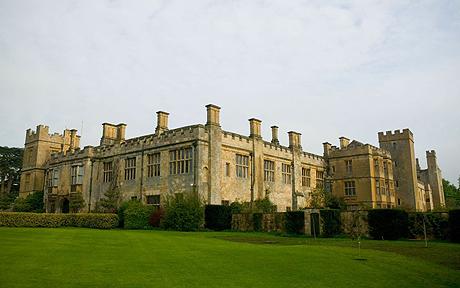
Sudeley Castle is a Grade I listed building and has played an important role in the turbulent and changing times of England’s past, with royal connections that stretch back over 1000 years. It is also the o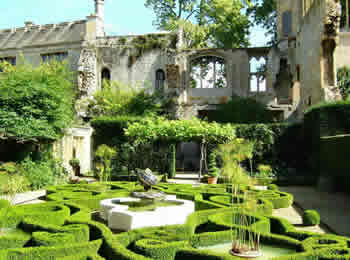 nly private castle in England to have a queen buried within its grounds – Katherine Parr, the last of Henry VIII’s six wives. Henry VIII also visited the castle with his second wife Anne Boleyn and Elizabeth I was entertained three times at Sudeley, including a spectacular feast in 1592 to celebrate the anniversary of the defeat of the Spanish Armada. nly private castle in England to have a queen buried within its grounds – Katherine Parr, the last of Henry VIII’s six wives. Henry VIII also visited the castle with his second wife Anne Boleyn and Elizabeth I was entertained three times at Sudeley, including a spectacular feast in 1592 to celebrate the anniversary of the defeat of the Spanish Armada.
Today it is a much-loved family home into which we will be admitted after normal visiting hours. The current owners are Elizabeth, Lady Ashcombe, widow of Henry Cubitt, 4th Baron Ashcombe, and her two children — Henry and Mollie Dent-Brocklehurst. After the death of Lady Ashcombe's husband Mark Dent-Brocklehurst in 1972, she owns 50% of the equity, while her children each own 25%.
Drinks in the Conservatory.
Followed by grand gala dinner in the Banqueting Hall.
Overnight: Lower Slaughter Manor, Lower Slaughter Village, England |
MONday
day 9 |
lower slaughter |
|
| |
|
Full breakfast in the hotel’s restaurant starting at 7:00 am.
Private closing-day visit of the house and gardens of Kelmscott Manor.
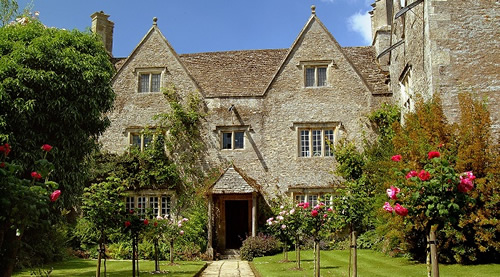
Kelmscott Manor, a farmhouse adjacent to the River Thames, was built around 1600, with an additional wing added to the north-east corner in about 1665. The Manor is built of local limestone on the edge of the village of Kelmscott.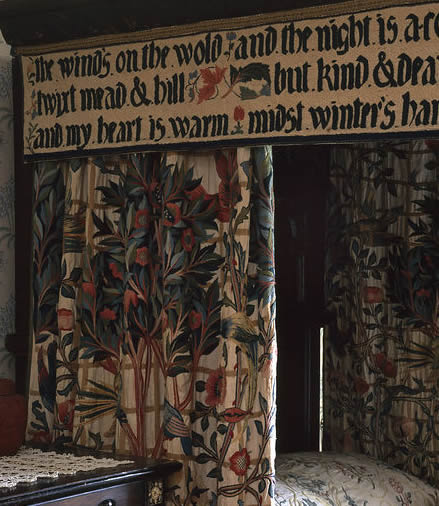
William Morris chose it as his summer home, signing a joint lease with the Pre-Raphaelite painter Dante Gabriel Rossetti in the summer of 1871. Morris loved the house as a work of true craftsmanship, totally unspoiled and unaltered, and in harmony with the village and the surrounding countryside. He considered it so natural in its setting as to be almost organic, it looked to him as if it had "grown up out of the soil" and he found that its beautiful gardens, with barns, dovecote, a meadow and stream, provided a constant source of inspiration.
The house contains an outstanding collection of the possessions and works of Morris, his family and associates (Benson, Burne-Jones, Rossetti and Webb among them), including furniture, original textiles, pictures, carpets, ceramics and metalwork. In addition to its furniture and furnishings, Kelmscott Manor also boasts a significant fine art collection, with important works by Rossetti, Sir Edward Burne-Jones, Albrecht Durer and Breughel.
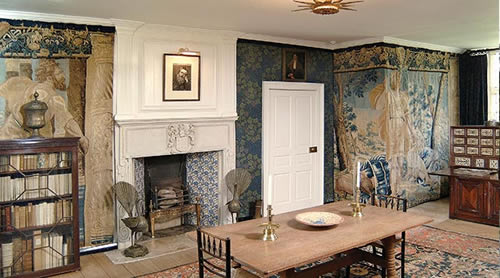
Light lunch at The Plough in Kelmscott.
Short transfer homewards for an afternoon guided walking visit of the town of Burford including the St John the Baptist Parish Church built in 1175.
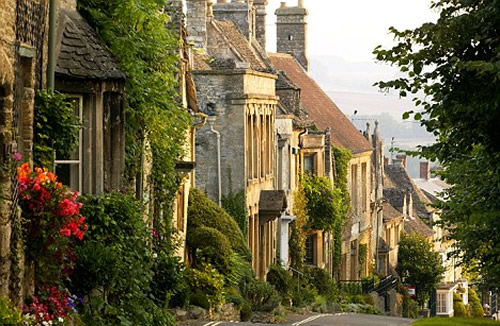
Burford, one of England's prettiest small medieval towns is a quiet community of about 1,000 people. The town merchants were granted a charter to hold their own markets over 900 years ago and the town prides itself on the long tradition of good service and the supply of excellent luxury and essential goods to both residents and visitors.
Transfer back to Lower Slaughter for the late afternoon free to prepare for tomorrow’s departure.
Drinks followed by our final goodbye dinner at the gastronomic restaurant of our hotel.
Overnight: Lower Slaughter Manor, Lower Slaughter Village, England |
tuesday
day 10 |
departures from lower slaughter to heathrow
or central london |
|
| |
|
Full breakfast in the hotel’s restaurant starting at 7:00 am.
Transfers arranged for travel either to London’s Heathrow Airport or to Central London. |
|
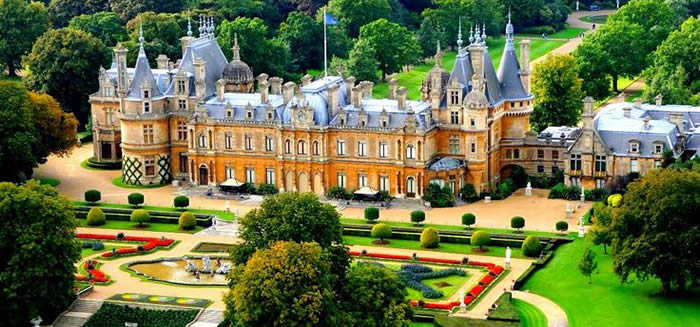




 nothing but farmland. He wanted a country retreat in the style of a Loire Valley château and that is exactly what he built. Waddesdon was created as a place to entertain guests at Ferdinand's famous Saturday-to-Monday house parties and they enjoyed all the modern comforts of running water, central heating and electricity. After a few years, Ferdinand discovered that the house was too small for the number of guests he wanted to entertain and added a wing at the west end of the house.
nothing but farmland. He wanted a country retreat in the style of a Loire Valley château and that is exactly what he built. Waddesdon was created as a place to entertain guests at Ferdinand's famous Saturday-to-Monday house parties and they enjoyed all the modern comforts of running water, central heating and electricity. After a few years, Ferdinand discovered that the house was too small for the number of guests he wanted to entertain and added a wing at the west end of the house. During the Second World War they housed children evacuated from London and after the war, James decided to leave the Manor, its collection and 165 acres of garden and park to The National Trust. To maintain the bequest, he set up the largest endowment the Trust has ever received and ensured the family’s continued involvement by naming his wife as the chairwoman of the management committee.
During the Second World War they housed children evacuated from London and after the war, James decided to leave the Manor, its collection and 165 acres of garden and park to The National Trust. To maintain the bequest, he set up the largest endowment the Trust has ever received and ensured the family’s continued involvement by naming his wife as the chairwoman of the management committee. garden's original splendor, including work on the beautiful carpet bedding on the Parterre and in the Aviary Garden, and renovation of the Water Garden at the Dairy. The collection of garden sculpture has also been enriched with the addition of works by contemporary artists.
garden's original splendor, including work on the beautiful carpet bedding on the Parterre and in the Aviary Garden, and renovation of the Water Garden at the Dairy. The collection of garden sculpture has also been enriched with the addition of works by contemporary artists. members of the court. The floors are covered with Savonnerie carpets exclusive to the Crown and walls hung with tapestries from the royal Gobelins and Beauvais workshops on top of sumptuous silk fabrics. Paintings from the 17th and 18th centuries by famous Dutch, Flemish and French artists subtly glow from the walls. Baron Ferdinand also prized 18th-century British portraits by Reynolds, Gainsborough and Romney.
members of the court. The floors are covered with Savonnerie carpets exclusive to the Crown and walls hung with tapestries from the royal Gobelins and Beauvais workshops on top of sumptuous silk fabrics. Paintings from the 17th and 18th centuries by famous Dutch, Flemish and French artists subtly glow from the walls. Baron Ferdinand also prized 18th-century British portraits by Reynolds, Gainsborough and Romney. include several superb paintings by Chardin, Labille-Guiard, Pannini and Callet, a magnificent silver dinner service made for George III and a large collection of Sèvres porcelain sculpture. Significant pieces of contemporary sculpture by Stephen Cox, Angus Fairhurst, Sarah Lucas and Richard Long can be seen in the garden and at the Windmill Hill complex that houses the Waddesdon Archive and Rothschild Foundation.
include several superb paintings by Chardin, Labille-Guiard, Pannini and Callet, a magnificent silver dinner service made for George III and a large collection of Sèvres porcelain sculpture. Significant pieces of contemporary sculpture by Stephen Cox, Angus Fairhurst, Sarah Lucas and Richard Long can be seen in the garden and at the Windmill Hill complex that houses the Waddesdon Archive and Rothschild Foundation.
-be43b11f-027f-4b36-a03a-371f5ab7c845-0-605x412.jpg)

 remained essentially unchanged since the 1630s due to the fact that Baddesley Clinton was the home of the Ferrers family for 500 years passing from father to son for 12 generations before finally being sold in 1940.
remained essentially unchanged since the 1630s due to the fact that Baddesley Clinton was the home of the Ferrers family for 500 years passing from father to son for 12 generations before finally being sold in 1940. simply a small room with a door hidden in the wood paneling. A second leads into the ceiling, and though not visible to visitors, is reputed to be able to hold six people. A third is hidden in an old toilet. Fugitives could slide down a rope from the first floor through the old garderobe shaft into the house's former sewers, which run the length of the building. These priest holes were built by Saint Nicholas Owen, a lay-brother of the Jesuits who made many masterful hides throughout England. He was eventually caught and tortured to death by the Protestant English government.
simply a small room with a door hidden in the wood paneling. A second leads into the ceiling, and though not visible to visitors, is reputed to be able to hold six people. A third is hidden in an old toilet. Fugitives could slide down a rope from the first floor through the old garderobe shaft into the house's former sewers, which run the length of the building. These priest holes were built by Saint Nicholas Owen, a lay-brother of the Jesuits who made many masterful hides throughout England. He was eventually caught and tortured to death by the Protestant English government. 
 "Apostles" and the four big specimens in the middle are 'The Evangelists'. A tight spiral path lined with box hedges climbs a hummock named "The Mount". The single yew that crowns the summit is known as "The Master". The smaller yew trees are called "The Multitude" and were planted in the 19th century to replace an orchard. Some of the yews at Packwood are taller than 50 feet and the garden appears on the cover of Sir Roy Strong’s book on “The Renaissance Garden in England.”
"Apostles" and the four big specimens in the middle are 'The Evangelists'. A tight spiral path lined with box hedges climbs a hummock named "The Mount". The single yew that crowns the summit is known as "The Master". The smaller yew trees are called "The Multitude" and were planted in the 19th century to replace an orchard. Some of the yews at Packwood are taller than 50 feet and the garden appears on the cover of Sir Roy Strong’s book on “The Renaissance Garden in England.”
 'Capability' Brown. A herd of fallow deer has been in the park since Tudor times. There are portraits of every generation of the family throughout the house and some of them have colorful stories to tell.
'Capability' Brown. A herd of fallow deer has been in the park since Tudor times. There are portraits of every generation of the family throughout the house and some of them have colorful stories to tell. ote estate. Meting out justice in the Great Hall, the local magistrate of the time was Sir Thomas Lucy. Shakespeare is said to have taken his revenge by portraying Sir Thomas as the fussy Justice Shallow in ‘The Merry Wives of Windsor’, poking fun at his coat of arms and his pride in his ancestors. One of the treasures of Charlecote’s exceptional library is the 1632 Second Folio of Shakespeare’s works.
ote estate. Meting out justice in the Great Hall, the local magistrate of the time was Sir Thomas Lucy. Shakespeare is said to have taken his revenge by portraying Sir Thomas as the fussy Justice Shallow in ‘The Merry Wives of Windsor’, poking fun at his coat of arms and his pride in his ancestors. One of the treasures of Charlecote’s exceptional library is the 1632 Second Folio of Shakespeare’s works.  r with Parliament during the tenure of Spencer's brother Robert. Finally, the youngest brother Richard inherited and allied himself with Charles II during the Restoration. The ‘reconciliation’ was helped by the payment of a hefty fine of £3,513 – equivalent to the Lucy family’s entire annual income from their estates and worth around £5.5 million today.
r with Parliament during the tenure of Spencer's brother Robert. Finally, the youngest brother Richard inherited and allied himself with Charles II during the Restoration. The ‘reconciliation’ was helped by the payment of a hefty fine of £3,513 – equivalent to the Lucy family’s entire annual income from their estates and worth around £5.5 million today. called in ‘Capability’ Brown to work on the gardens and in 1769 he helped revive the story of Shakespeare poaching Charlecote deer at the Shakespeare Jubilee organized by David Garrick in Stratford-upon-Avon.
called in ‘Capability’ Brown to work on the gardens and in 1769 he helped revive the story of Shakespeare poaching Charlecote deer at the Shakespeare Jubilee organized by David Garrick in Stratford-upon-Avon.
 proudly displayed Vernon family crest with the moto “Vernon always flourishes”, the theatrical family story reads like a soap opera and Steve Hindle will use the family to lead us through numerous interesting episodes in British history.
proudly displayed Vernon family crest with the moto “Vernon always flourishes”, the theatrical family story reads like a soap opera and Steve Hindle will use the family to lead us through numerous interesting episodes in British history. 
 year of residence at Coughton Court.
year of residence at Coughton Court. 

 ney family. But at this point the house and land changed hands a number of times, the property fell derelict and parts of the land and house were sold off. The situation was extremely sad but in 1993, the house was rescued by the Compton Verney House Trust, who purchased the house and immediate grounds thanks to a generous grant from the Peter Moores Foundation. The extensive building program gave it a new life as an art gallery. The building program started by conserving the Georgian Mansion and the adjacent servants buildings (now the Learning Center), then a contemporary extension between the two was created. The transformation took ten years to complete and Compton Verney was finally able to open its doors to welcome visitors in March 2004. Compton Verney is now a unique place where art, architecture, landscape and learning fuse.
ney family. But at this point the house and land changed hands a number of times, the property fell derelict and parts of the land and house were sold off. The situation was extremely sad but in 1993, the house was rescued by the Compton Verney House Trust, who purchased the house and immediate grounds thanks to a generous grant from the Peter Moores Foundation. The extensive building program gave it a new life as an art gallery. The building program started by conserving the Georgian Mansion and the adjacent servants buildings (now the Learning Center), then a contemporary extension between the two was created. The transformation took ten years to complete and Compton Verney was finally able to open its doors to welcome visitors in March 2004. Compton Verney is now a unique place where art, architecture, landscape and learning fuse. 
 s of royal and almost-royal great men who owned and embellished it - Geoffrey de Clinton, John of Gaunt, Henry V, and Robert Dudley, Earl of Leicester. Even in melancholy decay its influence has been far-reaching, thanks, in part, to Walter Scott’s best-selling romance, “Kenilworth” which brought the castle new fame.
s of royal and almost-royal great men who owned and embellished it - Geoffrey de Clinton, John of Gaunt, Henry V, and Robert Dudley, Earl of Leicester. Even in melancholy decay its influence has been far-reaching, thanks, in part, to Walter Scott’s best-selling romance, “Kenilworth” which brought the castle new fame.
 not least in the form of the new garden, recreated by English Heritage on the basis of a contemporary description, representing the one that Dudley had made for the 19 days of festivities laid on for Elizabeth I's visit in 1575.
not least in the form of the new garden, recreated by English Heritage on the basis of a contemporary description, representing the one that Dudley had made for the 19 days of festivities laid on for Elizabeth I's visit in 1575. 
 ne and on tour across the UK and internationally.
ne and on tour across the UK and internationally.



 proceeds from the wool trade were used to build St James's, a 500-year-old wool church to the north of the town. Examples of Early Modern architecture which survive in the town include the Market Hall, which was built in 1627 by Sir Baptist Hicks, and the Alms Houses, which were built in 1612 by the same architect. These houses, which are overlooked by the garden of the Eight Bells inn (a good place to have lunch), were intended to be the residence of twelve pensioners, a purpose for which they are still used today.
proceeds from the wool trade were used to build St James's, a 500-year-old wool church to the north of the town. Examples of Early Modern architecture which survive in the town include the Market Hall, which was built in 1627 by Sir Baptist Hicks, and the Alms Houses, which were built in 1612 by the same architect. These houses, which are overlooked by the garden of the Eight Bells inn (a good place to have lunch), were intended to be the residence of twelve pensioners, a purpose for which they are still used today. Morris. Its aim was to spark a revival in traditional craftsmanship, which had been in decline since the Industrial Revolution. In an effort to improve the quality of life of his craftsmen, Ashbee moved the Guild from workshops in the East End of London to Chipping Campden, in the center of the Cotswolds, in 1902.
Morris. Its aim was to spark a revival in traditional craftsmanship, which had been in decline since the Industrial Revolution. In an effort to improve the quality of life of his craftsmen, Ashbee moved the Guild from workshops in the East End of London to Chipping Campden, in the center of the Cotswolds, in 1902. pany which consists of four individual gold and silversmiths who share the work and the costs involved in running the workshop. Today, the craftsmen’s work is a mix of private commissions from tiny thimbles to larger pieces of presentational silverware, reproductions as well as commissions for the ecclesiastical silverware market. The business is run by David Hart, the grandson of one of Charles Ashbee’s original craftsmen who remained in Chipping Campden.
pany which consists of four individual gold and silversmiths who share the work and the costs involved in running the workshop. Today, the craftsmen’s work is a mix of private commissions from tiny thimbles to larger pieces of presentational silverware, reproductions as well as commissions for the ecclesiastical silverware market. The business is run by David Hart, the grandson of one of Charles Ashbee’s original craftsmen who remained in Chipping Campden.







 upon-Avon. Created by the talented American horticulturist, Major Lawrence Johnston its colorful and intricately designed outdoor ‘rooms’ are always full of surprises.
upon-Avon. Created by the talented American horticulturist, Major Lawrence Johnston its colorful and intricately designed outdoor ‘rooms’ are always full of surprises. 

 constructed, the grandstand consisted of two levels with a flat roof and a basement. The ground floor was the entrance hall for welcoming guests, and the first floor consisted of the Great Room where the guests were entertained. The deer coursing could be observed from the flat roof or from the balcony over the portico. It is England's only surviving 17th-century deer course and grandstand.
constructed, the grandstand consisted of two levels with a flat roof and a basement. The ground floor was the entrance hall for welcoming guests, and the first floor consisted of the Great Room where the guests were entertained. The deer coursing could be observed from the flat roof or from the balcony over the portico. It is England's only surviving 17th-century deer course and grandstand. 

 the woods when their ferret got stuck down a hole. As they dug the ferret out, a small patch of mosaic pavement was revealed. Realizing the significance of the find they reported it and it came to the attention of the young landowner, 19-year-old Lord Eldon. His uncle and guardian, James Farrer, was a keen antiquarian and organized excavation of the site over the summer of 1864.
the woods when their ferret got stuck down a hole. As they dug the ferret out, a small patch of mosaic pavement was revealed. Realizing the significance of the find they reported it and it came to the attention of the young landowner, 19-year-old Lord Eldon. His uncle and guardian, James Farrer, was a keen antiquarian and organized excavation of the site over the summer of 1864.
 Beauty. The village has a population of 3,297 inhabitants making it a rather large village as its population actually exceeds those of nearby Stow-on-the-Wold and Burford, both of which are considered small market towns. The village is known for its picturesque High Street, flanked by long wide greens and the River Windrush that runs through them. The river is crossed by several low, arched stone bridges. These arched bridges have led to Bourton-on-the-Water being called the "Venice of the Cotswolds".
Beauty. The village has a population of 3,297 inhabitants making it a rather large village as its population actually exceeds those of nearby Stow-on-the-Wold and Burford, both of which are considered small market towns. The village is known for its picturesque High Street, flanked by long wide greens and the River Windrush that runs through them. The river is crossed by several low, arched stone bridges. These arched bridges have led to Bourton-on-the-Water being called the "Venice of the Cotswolds". 
 nly private castle in England to have a queen buried within its grounds – Katherine Parr, the last of Henry VIII’s six wives. Henry VIII also visited the castle with his second wife Anne Boleyn and Elizabeth I was entertained three times at Sudeley, including a spectacular feast in 1592 to celebrate the anniversary of the defeat of the Spanish Armada.
nly private castle in England to have a queen buried within its grounds – Katherine Parr, the last of Henry VIII’s six wives. Henry VIII also visited the castle with his second wife Anne Boleyn and Elizabeth I was entertained three times at Sudeley, including a spectacular feast in 1592 to celebrate the anniversary of the defeat of the Spanish Armada. 


